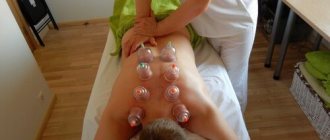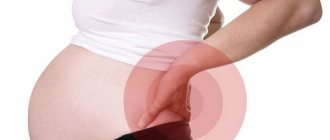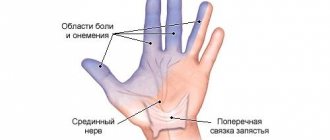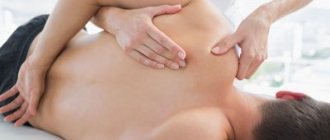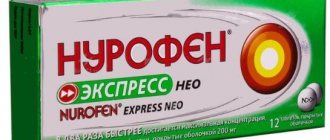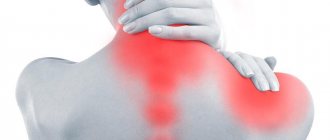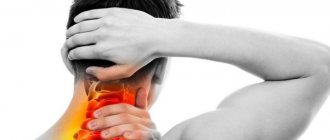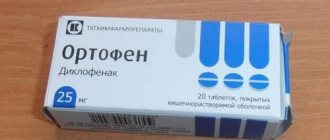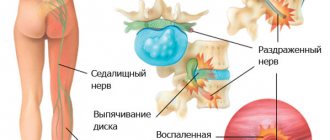One of the reasons for pain in the rib area is pinching of the intercostal nerve (neuralgia). Painful manifestations are usually localized between the ribs on the right or left, and can also penetrate the back all the way to the lower back. This disease is not independent, but develops as a result of damage to the spinal column. In this case, damage to the nerve fibers is caused by a narrowing of the openings between the vertebrae through which they exit, due to pathological changes in the discs, the vertebrae themselves, or their relative positions. The symptoms of neuralgia are very diverse and sometimes similar to the manifestations of other diseases.
Causes
The factors that provoke pinching of the intercostal nerve are the same reasons that cause spinal injuries:
- injuries to the ribs and upper back;
- osteochondrosis;
- osteoporosis, joint diseases;
- scoliosis;
- disc herniation or protrusion;
- salt deposits;
- complications after infections;
- increased load on the musculoskeletal system due to obesity;
- chronic alcoholism;
- nervous disorders;
- general hypothermia;
- too much or too little physical activity;
- peripheral nerve damage in diabetes;
- endocrine disorders in women;
- changes in the musculoskeletal system caused by pregnancy;
- genetic predisposition to such diseases.
In addition to the primary causes, pinching of the intercostal nerve can be caused by any increase in the load on the spine, prolonged stay in an uncomfortable position, as well as age-related changes or decreased immunity.
Establishing the exact cause of pain associated with neuralgia is necessary to prescribe the correct treatment. It is not the pain that needs to be eliminated, but the underlying disease that led to the pinching of the intercostal nerve.
Principles of a healthy back
What do you mean by a healthy back? We are sure: the secret to a healthy spine is moderate and reasonable exercise, regular prevention and a healthy lifestyle. Then each of the vertebrae and intervertebral discs will serve you faithfully for many years!
We, the Drevmass team, highlight three key principles for a healthy back:
- Spinal stretch (traction)
- Strengthening the muscle corset
- Improving the blood circulation process
There is a solution - a special Drevmass simulator, the effectiveness of which has been confirmed by tests and certifications. Just 5 minutes a day - and very soon you will feel the result!
Especially for you, we have prepared video instructions with the simplest and most effective exercises that you can start doing from the first day of training on the Drevmass simulator:
Symptoms
Intercostal neuralgia is manifested by pain, the nature and severity of which is determined by the degree of pinching of the nerve and its location. In this case, pain has a number of characteristics:
- The onset is acute, piercing, highly intense, reminiscent of an electric shock or a heart attack, which is due to the special sensitivity of the clenched fibers.
- After a few minutes, the pain decreases, but with the slightest movement it returns again or becomes wave-like.
- Most often, the pain is felt on one side of the chest, radiating under the shoulder blade or below, and when localized on the left side, it resembles a sharp tingling sensation in the heart.
- There is a close connection with inhalation - as the chest expands, the pain increases significantly.
- A burning sensation, tingling or decreased sensitivity may occur at the site of pinched roots.
Also, pain appears when there is a sudden change in posture or palpation of the ribs, radiating to the stomach, neck, shoulder or other parts.
In addition, pinching of the intercostal nerve can lead to dysfunction of nearby internal organs. Most often, tachycardia and angina pectoris develop, the acidity of gastric juice increases, intracranial and blood pressure rises, and congestion appears in the lungs. The last symptom is especially painful, since the combination of neuralgia with cough does not stop the attack and can significantly aggravate the symptoms of the disease.
To differentiate neuralgic pain in the left intercostal space from an attack of angina, you should know that the manifestations of a heart attack do not depend on the movement or coughing performed, and are also reduced when taking the appropriate medication.
However, during a heart attack, the pain is also not eliminated by a pill, so if you suspect a cardiac pathology, you need to call a doctor and do an ECG.
When the nerves of the lower ribs are damaged, symptoms of renal colic may appear. In very rare cases, signs of intercostal neuralgia resemble manifestations of diseases of the chest organs - lungs, mediastinum and others.
Intercostal neuralgia on the right side under the ribs
Very often, a pinched thoracic nerve is confused with heart disease. The symptoms of these diseases are indeed somewhat similar. However, you can try to determine the cause of the pain yourself.
When a nerve is pinched, the pain can be prolonged and not stop day or night. If the heart muscle is pinched, the pain is paroxysmal and goes away over some time. Usually accompanied by a decrease or increase in blood pressure.
For neuralgic diseases, taking conventional analgesics or heart medications does not help. When palpating the intercostal areas, the pain intensifies. In case of cardiovascular diseases, pain can be relieved with the help of special medications or analgesics.
With neuralgic diseases, pain can radiate to the arm, lower back, shoulder, under the shoulder blade or neck. In heart disease, pain is localized only in the chest and heart.
With neuralgia, the pain intensifies when moving the arm, head, rotating or turning the body, sneezing and coughing, taking a deep breath and any change in body position. In heart disease, stiffness in the chest is permanent and does not change when changing body position or when inhaling and exhaling.
A pinched nerve can occur suddenly and in any, even the most inappropriate place and situation. In this case, you must first call a doctor and provide first aid to the victim before he arrives.
To do this, you need to lay the patient on a hard surface, lay a soft blanket or blanket on top of it and ensure his immobility. The patient should lie in the position in which the least pain is felt. In this case, it is necessary to free his chest from tightly squeezing clothing and provide access to fresh air.
Typically, a pinched nerve is accompanied by severe unbearable pain, so you should try to numb the pinched area with analgesics. Due to the suddenness of the pinching, the patient may experience not only unbearable pain, but also nervous shock. In this condition, the patient needs to be given sedatives.
Upon arrival of the doctor, it is necessary to tell about all the medications that have already been given to the patient. Hospitalization occurs only in the most complicated cases. Usually the doctor numbs the area of pain, taking into account the medications already taken, and recommends further examination.
Many also like to use the highly effective warming and powerful analgesic ointment “Finalgon”. And among professional athletes, the use of “horse” ointment for traumatic and neuralgic pain is flourishing (but the latter has a significant number of contraindications).
Cardiac symptoms are “indifferent” to the depth of exhalation and inhalation; they also do not intensify with changes in position or movements. In addition, as a rule, they are removed by using nitroglycerin tablets. They may, unlike neuralgia, be accompanied by pulse rhythm disturbances, an increase or decrease in blood pressure.
Garlic oil helps eliminate neuralgia. No more than 25 ml of oil is diluted in 500 ml of cognac or alcohol. The resulting essence should be lubricated on the forehead and temples, which helps eliminate attacks. The homeopathic effect is realized.
- During the period when the patient experiences acute pain, the following measures are indicated:
Lack of minerals and vitamins.
- Intercostal neuralgia is a pathological process that develops when a nerve is compressed or irritated. The pain can be excruciating, severe, and of high intensity. Most often they are localized in the spine or sternum.
Destabilization of blood pressure;
- For viral etiology of neuralgia (shingles, ARVI), specific antiviral treatment is prescribed using immunostimulating therapy and sedatives.
Injuries, intoxication
- Blockades. In the area of the nerve, in case of excessive pain, it is necessary to inject Novocaine, Lidocaine, etc. with drugs from the group of anesthetics.
Stress - frequent and severe stressful situations have an active negative effect on the entire nervous system, including the intercostal nerves;
It is important to remember that all such home self-help remedies can only relieve pain temporarily, but not eliminate its main cause. And in order not to provoke the onset of the disease, it is important to maintain correct posture, relax in time and not overstrain your back (and in case of overstrain, maintain gentle conditions so as not to provoke painful consequences).
Treatment methods are varied. They depend on the causes of the disease, the individual characteristics of the patient’s condition, the treatment approach itself (traditional medication, procedural, traditional and alternative medicine).
Folk treatment for intercostal neuralgia contains the following recipe: a simple hard-boiled egg. When hot, it is applied to the sore spot until it cools completely. When the egg becomes cold, the pain should go away.
- Bed rest for several days. The bed should be firm and level, a shield should be placed under the mattress.
- Tumors of the thoracic spine.
- The disease is often perceived as a sign of other diseases, so it is important to understand what the main symptoms of intercostal neuralgia on the right and left are. It is necessary to listen carefully to the signals that the body gives and clearly explain your condition to the doctor.
- Migraine-type headache;
In case of severe pain, the patient is prescribed strict bed rest with staying on a hard surface and maximum immobilization - avoiding sudden movements that provoke pain.
- This pain symptom can be provoked by microtraumas, injuries and intoxications of the body, both external (bacterial toxins, heavy metals, some medications) and internal (due to diseases of internal organs).
- Electrophoresis with analgin or novocaine. Analgesic effect. Session duration is 5-7 minutes, course of treatment is 10 days.
- Multiple sclerosis - causes total damage to the nervous system, including chronic irritation of the intercostal nerves;
— you need to take a very deep breath of air into your lungs, open your chest wide, hold your breath for as long as you can stand it, then slowly exhale the air through your lips, folded into a tube, slowly, slowly. Slowly the chest drops.
Thus, when the chest expands, the nerve that is compressed by the surrounding tissue is released.
This is how I save myself on the advice of a good neurologist about pain.
I would like to add that with intercostal neuralgia it is rare, but there is temporary complete paralysis of the body. Usually at night, when a person is sleeping, he wakes up from a sharp pain in the chest (usually on the left side) - the nerve is compressed by the surrounding tissues and squeezes it - the person wakes up and realizes that he cannot move at all.
I went to the cardiologist in the morning, they did a cardiogram - my heart was normal.
Try to breathe as deeply as possible, arching your back while lying on your back and exhale very slowly, it should help, but not immediately. Pay attention to your posture, pull yourself together, do the following exercises: “kitty”, standing on all fours, lower your head to the floor and then stretch your back, stretch your entire stomach to the floor and rise on your hands (like a cat pulls itself up after lying down), fish on land (lying down, do not lift your stomach arms and legs at the same time and standing on your legs and arms with your back to the floor like a turtle, make movements with your groin up (the spine weakens, then becomes tense), the doctor recommended it himself, then he bought a book, these exercises were indicated there.. All the best.
Thus, when the chest expands, the nerve is released.
Intercostal neuralgia is not a common ailment, characterized by sudden squeezing or piercing pain in the chest area. More often this is a consequence of advanced osteochondrosis or compression of the nerve roots by intervertebral hernias.
The nature of the pain can be different: acute and constant pain or dull paroxysmal pain. Unpleasant sensations are only intensified by any movement, deep breathing, or coughing. More often, patients complain of pain concentrated between the ribs, which intensifies with palpation and pressure. Intercostal neuralgia is an attack of acute, cutting, spasmodic and stabbing pain that surrounds the chest.
During an acute attack, the pain is so strong that it can paralyze a person’s movements. He can't even breathe fully because of the discomfort in his chest. In addition to a pinched nerve, chest pain can indicate many other diseases that are similar in symptoms and signs, however, in order to determine this in time, you need to seek emergency medical help and undergo an examination.
Diagnostics
Diagnosis of a pinched intercostal nerve is made based on a survey and examination of the patient. In this case, the survey results are interpreted as follows:
- at the site of compression of the nerve, the skin changes color - turns red or pale;
- upon palpation, pain appears along the pinched nerve between the ribs;
- examination (palpation, tapping, listening) of the heart excludes the presence of its diseases.
Additional diagnostic measures are prescribed to differentiate neuralgia from other pathologies if there is any suspicion. The following may be used:
- electrocardiogram;
- X-ray examination;
- Ultrasound of the peritoneal and retroperitoneal cavity;
- MRI or myelography of the spine.
For any diagnosis, a blood test is required to monitor the presence of inflammation. Only an accurate diagnosis will help prescribe adequate treatment that will ensure maximum results.
First aid
For sharp, unbearable pain in the back of the back that appears as a result of injury or heavy physical exertion, you can take a drug with an analgesic effect (Analgin, Ibuprofen, Ketorol).
If the pain is caused by a disturbance in the functioning of the heart, you should call an ambulance and take nitroglycerin in a dosage of one tablet under the tongue for resorption.
Pain in the back can bother women before their period. In this case, it is recommended to take an antispasmodic drug (Spazmalgon). Taking No-shpa will help eliminate spasms during inflammation of the digestive and urinary organs.
For diseases of internal organs, treatment is prescribed by the doctor depending on which organ is affected.
If the problems are muscle weakness, musculoskeletal disorders and certain neurological diseases, the following treatment methods are used:
- physiotherapeutic treatment (ultrasound waves, laser radiation, electrophoresis, exposure to magnetic fields);
- therapeutic massage - at first, movements when massaging muscles are performed smoothly and easily, after which more intense rubbing and kneading are used; For a warming effect, use a special massage cream or vegetable oils;
- acupuncture - using needles to apply pressure to points responsible for the functions of internal organs; performed by trained specialists; yoga classes – regular exercises help strengthen the back muscles, improve their elasticity, strengthen the immune system and improve overall health;
- therapeutic exercises - to reduce the load on the spine, you should perform daily, simple exercises: bending your back forward, backward and to the sides; standing on all fours, bend your back down and arch it up; clasping your hands behind you in a lock, slowly bend down; align your arms at the seams and make circular movements with both shoulders at the same time;
- Regular swimming and daily walks over long distances will help strengthen your muscles.
Treatment
After establishing the root cause of intercostal neuralgia, complex treatment is applied, including:
- drug therapy;
- physiotherapeutic procedures;
- massage, exercise therapy;
- folk remedies.
In addition, drugs may be prescribed that improve blood circulation, restore bone and cartilage tissue, normalize metabolic processes and increase the body's immune defense. During pregnancy, only products that are harmless for this condition are used - vitamins and ointments on a natural basis.
In case of exacerbation of intercostal neuralgia, the patient must be provided with gentle bed rest for 7 days. At the same time, he should lie on a hard surface under a warm but light blanket.
Conservative therapy
Drug treatment of neuralgia is carried out in 2 stages:
- Pain relief: relief, optimally - complete elimination of pain symptoms by taking anesthetic and non-hormonal anti-inflammatory drugs, in severe situations - using glucocorticosteroids. Sometimes blockades and muscle relaxants are used.
- The main treatment: getting rid of the root cause of the pinching and restoring the nerve itself. Drugs are prescribed in accordance with the diagnosis, severity of symptoms and other features of the course of the disease.
To relieve pain and eliminate inflammation, the following are used:
- topical preparations - ointments based on diclofenac;
- means for oral administration - various analgesics and antispasmodics;
- novocaine and lidocaine blockades into the muscle tissue surrounding the damaged area of the spine.
In addition, to treat the underlying disease that has become the root cause of neuralgia, different groups of drugs are used - antibiotics, neuroprotectors, immunostimulants, vitamins and other drugs. To restore the mobility of the spine, chondroprotectors are used, the most effective of which is considered to be Chondroxide. This video talks about intercostal neuralgia, its symptoms and treatment methods.
In case of serious damage and severe nerve entrapment, when medication methods are ineffective, surgical intervention is prescribed. During the operation, the compressed nerve is released, the vertebrae, discs, and cartilage are corrected.
Physiotherapy, massage, exercise therapy
To eliminate the consequences of a pinched intercostal nerve, several types of physiotherapeutic procedures are used:
- electro- and phonophoresis;
- paraffin applications;
- UHF;
- electric current, laser and magnetic therapy.
Also, after eliminating the exacerbation, it is recommended to perform massage procedures and therapeutic exercises to return the normal functionality of the nerve fibers and surrounding tissues. Exercises are selected in accordance with the severity of symptoms, the nature of the underlying disease and the personal characteristics of the patient. In addition, during remission, it is advisable to undergo treatment in a sanatorium in this area.
ethnoscience
To speed up recovery, home treatment is used along with conservative treatment. The following recipes are usually used:
- Dry heat - pepper plaster, mustard plasters or heated sand wrapped in cloth, but only on the ribs and along the spine, without affecting the spinal column.
- Ointments with snake or bee venom are applied to the painful area, which is then covered with a woolen cloth or a belt made of camel hair.
- Rubs using fir oil, black radish, horseradish rhizomes or geranium leaves infused with valerian alcohol, capsicum, garlic, bay leaf - any of these remedies are rubbed along the nerve, and then the sore spot is wrapped in something warm.
- Applications from a hard-boiled egg - one half is applied directly to the painful area, the other - to its projection on the other side of the body.
Along with external effects, it is recommended to drink the following decoctions and infusions:
- From willow bark - 1 tsp. raw materials per 250 ml of boiling water, steam and simmer for 15 minutes at a barely noticeable boil. Cool, take 1 tbsp. l. 4 times a day;
- From mint or lemon balm - brewed like regular tea. Drink throughout the day as desired, but the total amount is at least 4 glasses.
- From chamomile - 70 g of raw material is brewed with 1 cup of boiling water, steamed for 5 minutes. Let it brew. Take 50 ml after each meal.
- From immortelle - infuse tea from 2 tbsp in a thermos overnight. l. herbs steamed with 2 cups of boiling water. In the morning, filter and drink the entire volume throughout the day in equal portions.
- From apricot kernels - 3 tbsp. l. grated apricot cores are mixed with 0.5 kg of lemons grated with peel and 0.5 kg of liquid honey. Take 1 tbsp daily after breakfast and dinner. l. mixture until it runs out. If necessary, the course is repeated.
Baths made from aspen bark will also be useful. They should be taken every evening, preparing a decoction and adding it to the bath water. The temperature should be such that the body warms up well. After the procedure, the painful area is immediately insulated overnight with a woolen scarf.
The use of any home remedies will be advisable only in the absence of physical activity and ensuring a state of rest, especially for the damaged area of the spine. If the negative impact of external factors continues, the treatment will not give any result.
By combining all of these folk remedies with each other, as well as supplementing them with conservative therapy, you can significantly increase the effectiveness of eliminating the consequences of a pinched intercostal nerve. But it’s even better to prevent the occurrence of this serious disease or at least prevent its reappearance.
Why does pain appear in the left hypochondrium?
Most people associate the left side with the heart, therefore, when pain appears in the hypochondrium on this side, many tend to “sin” precisely on this most important organ. In fact, pain in the left hypochondrium occurs much more often for completely different reasons.
Spleen diseases
If we consider the causes of pain of this type, one of the most common is diseases of the spleen.
With such diseases, the spleen can increase in size until it ruptures, so it is extremely important to consult a doctor in a timely manner and begin treatment. The cause of rupture of this organ can be other problems - inflammation, splenic infarction or infectious mononucleosis
Rupture of this organ can also be caused by other problems - inflammation, splenic infarction or infectious mononucleosis.
Stomach problems
Symptoms of its development appear in the early stages of the disease, but most people tend to ignore them. And in the later stages, when gastritis begins to develop into a peptic ulcer, the pain spreads not only to the hypochondrium, but also radiates to the back.
Like most diseases, treatment of gastritis in the early stages of its development is usually quite simple and quickly gives a positive effect, but if you ignore such pain for a long time, then over time you have to treat peptic ulcer disease, which is much more difficult.
A dull girdle pain in the left hypochondrium often indicates the development of chronic diseases of the pancreas, and if they are not treated, then very soon the development of an acute form of pancreatitis will begin, which will add to the “overall picture” such unpleasant symptoms as fever and vomiting.
This is not a very common problem, but pain in the left hypochondrium may well indicate its occurrence. In a diaphragmatic hernia, part of the stomach and esophagus enters the chest through the diaphragmatic ring.
The causes of this condition usually lie in heavy physical activity, but in some cases this problem occurs with obesity and pregnancy.
Heart problems
This is perhaps the most discussed and well-known reason for the appearance of pain of this type, although in terms of prevalence it is not at all in first place. The causes of such pain are myocardial infarction, cardiomyopathy and coronary heart disease.
The presence of such symptoms may indicate a myocardial infarction. There is one more difference - with heart problems, the pain usually has a paroxysmal nature, that is, it quickly intensifies, reaches a certain “peak” and recedes for a while. With other diseases, the pain is either constant or the “attacks” last longer.
Such disorders are also in some cases the cause of this type of pain. For example, a vegetative crisis usually manifests itself as pain on the left under the ribs. Such problems do not disappear on their own; if such symptoms occur, you should immediately consult a doctor and begin treatment.
The appearance of pain in the hypochondrium (even relatively mild) is always a fairly serious symptom, which is extremely dangerous to ignore.
Almost always, the efficiency and success of treatment depends precisely on how timely the disease was diagnosed and how correctly the treatment was prescribed, and if the latter parameter depends entirely on the doctor, then the first depends only on when the person decides to go to the clinic and undergo an examination . Self-medication in such cases is often harmful, so you should not delay contacting a therapist.
Prevention
The rules for preventing intercostal neuralgia are quite simple:
- Prevention of injuries to the musculoskeletal system, especially its upper part.
- Maintaining a posture that prevents curvature of the spine.
- Take regular breaks if you need to stay in one position for a long time, especially if you feel discomfort in your neck or back. Perform massage and light exercises to relieve tension.
- Improved physical fitness. If necessary, normalize body weight.
- Control of your movements, no sudden jerks, no lifting of unbearable weights.
- Stretching before active sports or increased physical activity.
- Avoiding stress that negatively affects the entire nervous system. Positive attitude and calmness.
- Immediate treatment of any spinal diseases that can cause damage to nerve fibers.
At the first signs of neuralgia, you should immediately seek medical help. The recovery process can be long, but with an integrated approach and compliance with all medical prescriptions, this dangerous pathology can be cured, avoiding possible complications.
Self-diagnosis and treatment: what to do if your side on the rib side hurts from time to time?
Only a professional, i.e., can accurately determine the cause of back pain under the right rib. doctor. BUT you can make his task much easier by preparing for the visit. To do this, listen to yourself and answer the following questions:
The methods and treatment program are drawn up exclusively by the doctor. All we recommend doing on your own is to relieve pain in the acute phase. Painkillers (analgesics, antispasmodics, anti-inflammatory drugs), folk remedies (ointments, compresses, warming) and special exercises to relieve acute back pain will cope with the task.
However, their choice also needs to be approached with caution.
